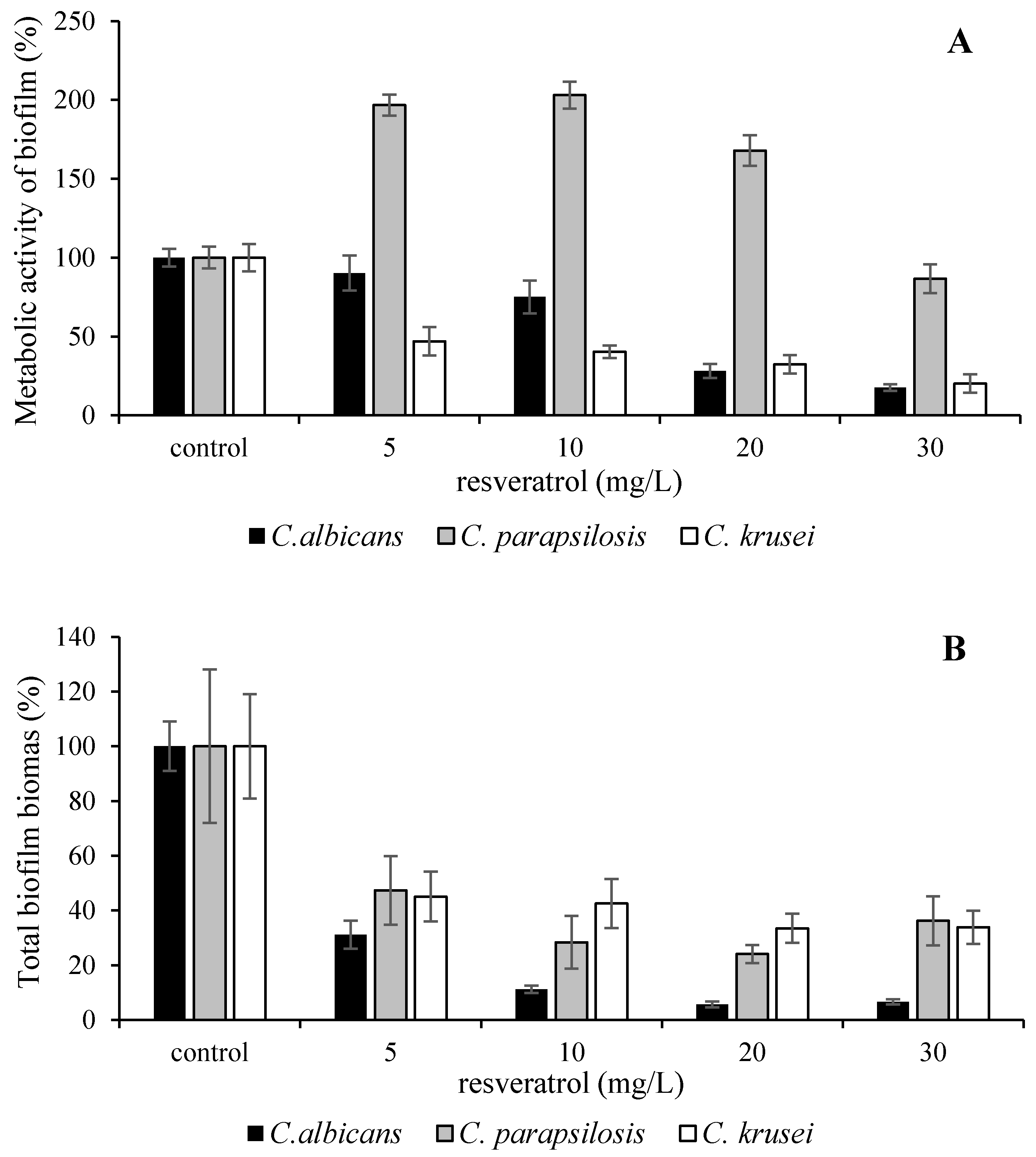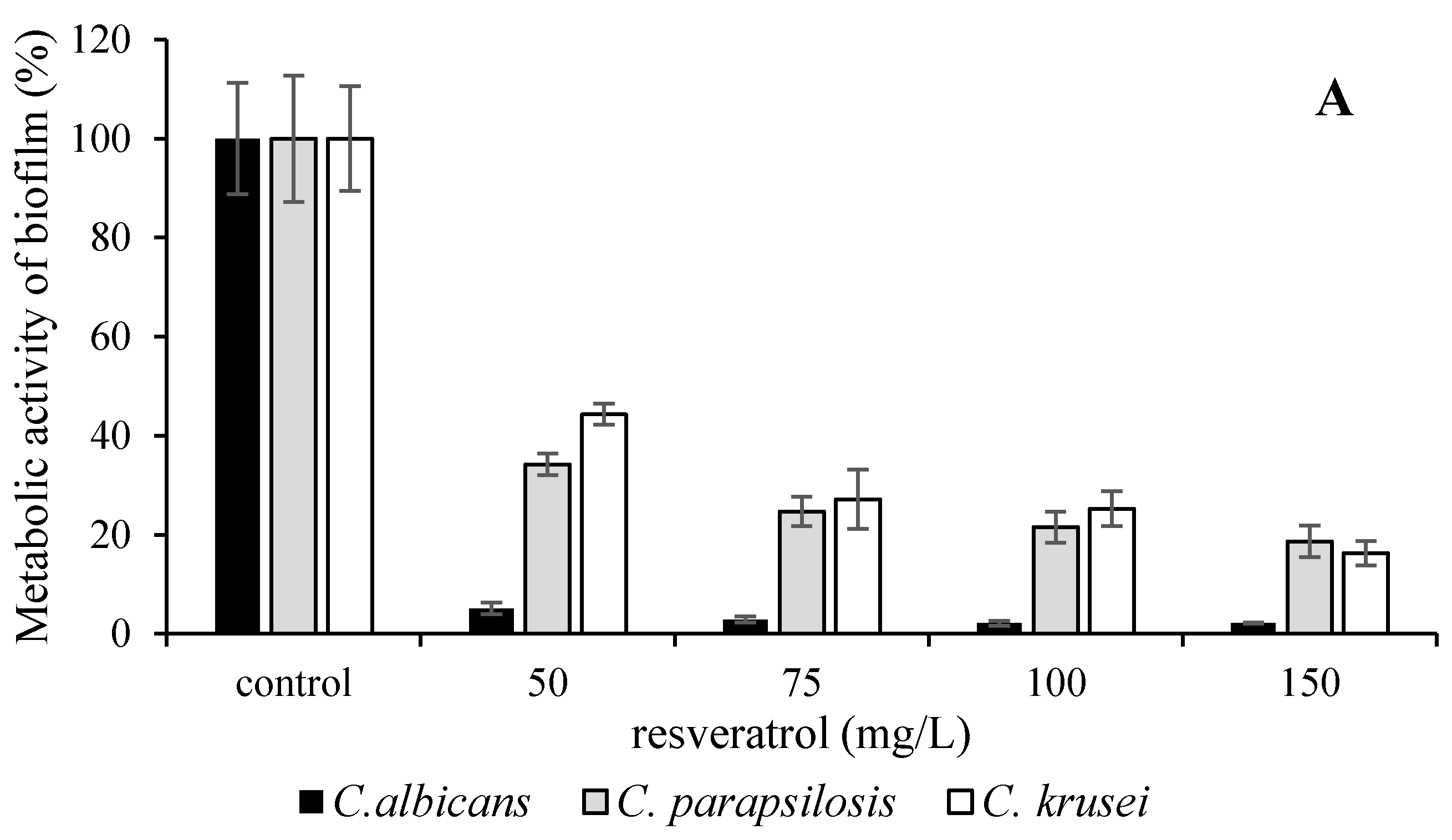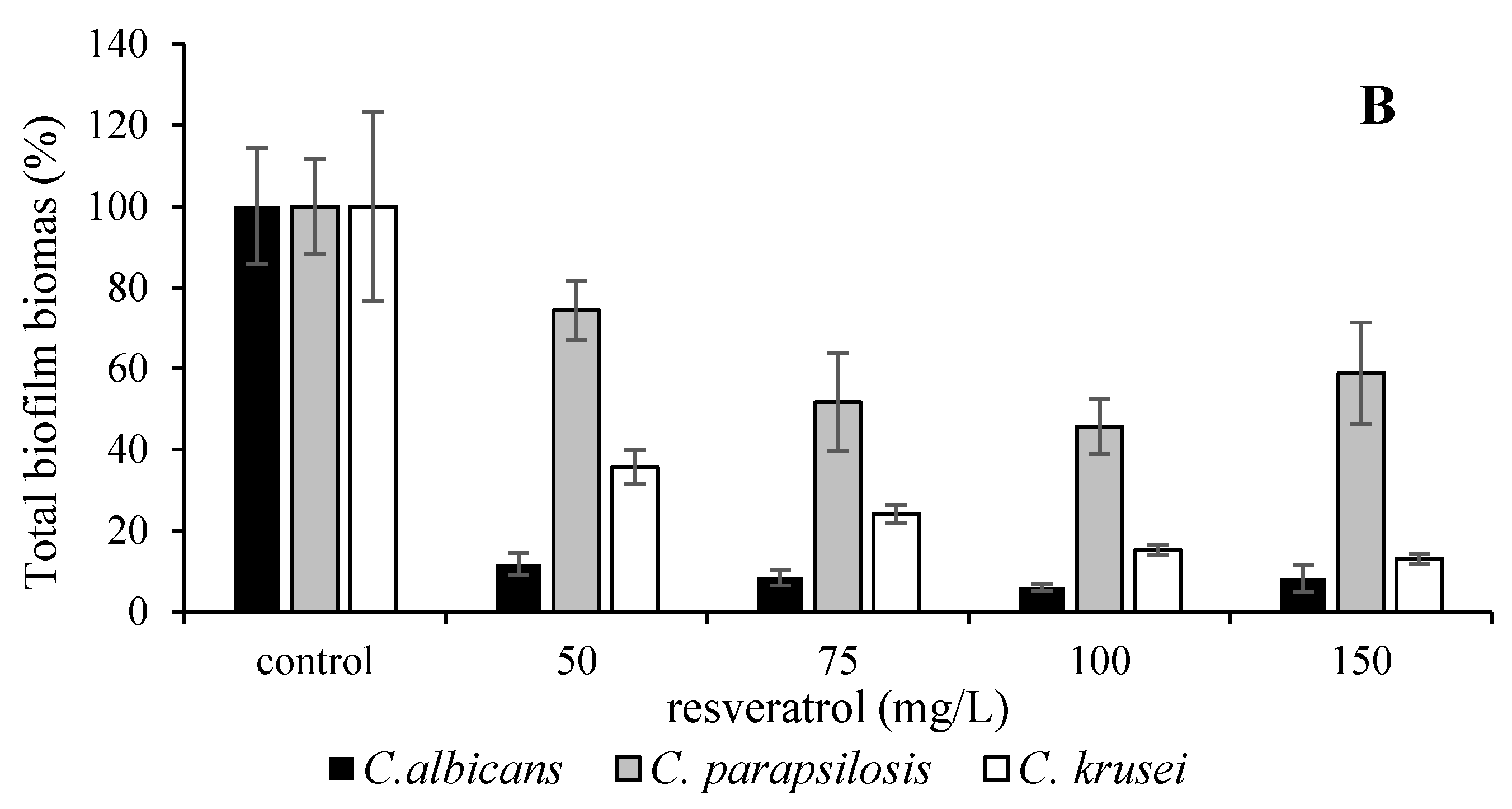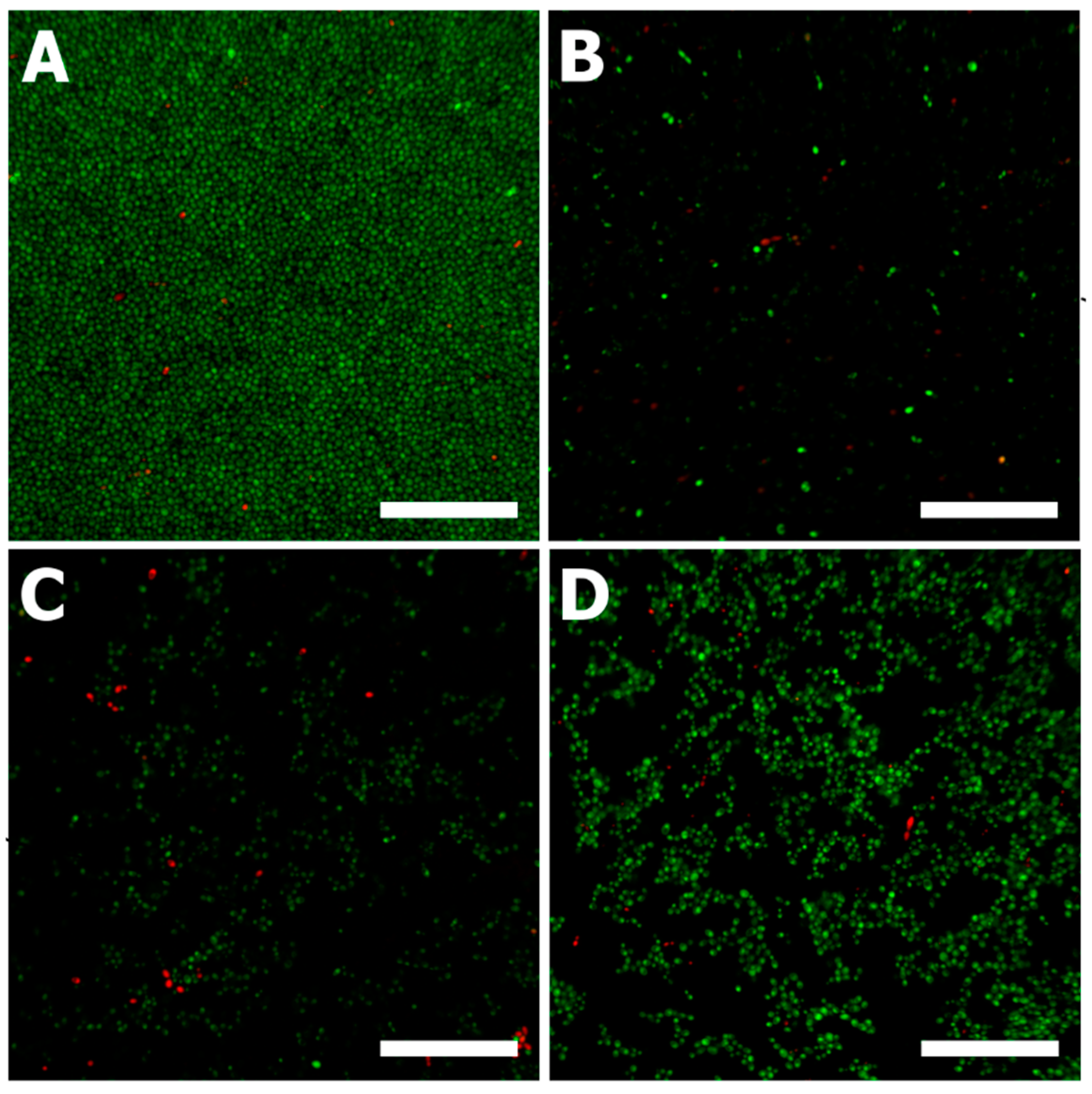Composition and Biological Activity of Vitis vinifera Winter Cane Extract on Candida Biofilm
Abstract
:1. Introduction
2. Materials and Methods
2.1. Yeast and Culture Conditions
2.2. Biologically Active Agents
2.3. Minimum Inhibitory Concentration Determination
2.4. Minimum Biofilm Inhibitory Concentration Determination
2.5. MTT Assay
2.6. Crystal Violet Staining
2.7. Light Microscopy—Cellavista Device
2.8. Spinning Disc Confocal Microscopy
2.9. Determination of Total Antioxidant Activity
2.10. The Amount of Total Phenolic Groups
2.11. Statistical Analysis
3. Results and Discussion
4. Conclusions
Author Contributions
Funding
Institutional Review Board Statement
Informed Consent Statement
Data Availability Statement
Conflicts of Interest
References
- Tsao, R. Chemistry and Biochemistry of Dietary Polyphenols. Nutrients 2010, 2, 1231–1246. [Google Scholar] [CrossRef]
- Squillaci, G.; Giorio, L.A.; Cacciola, N.A.; La Cara, F.; Morana, A. Effect of temperature and time on the phenolic extraction from grape canes. In Wastes-Solutions, Treatments and Opportunities III; Vilarinho, C., Castro, F., Conçalves, M., Fernando, A.L., Eds.; CRC Press: Abingdon, UK; Taylor & Francis Group: Abingdon, UK, 2020; pp. 34–40. [Google Scholar]
- De Filippis, B.; Ammazzalorso, A.; Amoroso, R.; Giampietro, L. Stilbene derivatives as new perspective in antifungal medicinal chemistry. Drug Dev. Res. 2019, 80, 285–293. [Google Scholar] [CrossRef]
- Daglia, M. Polyphenols as antimicrobial agents. Curr. Opin. Biotechnol. 2012, 23, 174–181. [Google Scholar] [CrossRef]
- Shukla, Y.; Singh, R. Resveratrol and cellular mechanisms of cancer prevention. Ann. N. Y. Acad. Sci. 2011, 1215, 1–8. [Google Scholar] [CrossRef]
- Dixon, R.A. Natural products and plant disease resistance. Nat. Cell Biol. 2001, 411, 843–847. [Google Scholar] [CrossRef]
- Kolouchova, I.; Melzoch, K.; Smidrkal, J.; Filip, V. The content of resveratrol in vegetables and fruit. Chem. Listy 2005, 99, 492–495. [Google Scholar]
- Filip, V.; Plocková, M.; Šmidrkal, J.; Špičková, Z.; Melzoch, K.; Schmidt, Š. Resveratrol and its antioxidant and antimicrobial effectiveness. Food Chem. 2003, 83, 585–593. [Google Scholar] [CrossRef]
- Wang, W.; Tang, K.; Yang, H.-R.; Wen, P.-F.; Zhang, P.; Wang, H.-L.; Huang, W.-D. Distribution of resveratrol and stilbene synthase in young grape plants (Vitis vinifera L. cv. Cabernet Sauvignon) and the effect of UV-C on its accumulation. Plant Physiol. Biochem. 2010, 48, 142–152. [Google Scholar] [CrossRef]
- Gorena, T.; Sáez, V.; Mardones, C.; Vergara, C.; Winterhalter, P.; von Baer, D. Influence of post-pruning storage on stilbenoid levels in Vitis vinifera L. canes. Food Chem. 2014, 155, 256–263. [Google Scholar] [CrossRef]
- Kang, K.; Fong, W.-P.; Tsang, P.W.-K. Antifungal Activity of Baicalein against Candida krusei Does Not Involve Apoptosis. Mycopathologia 2010, 170, 391–396. [Google Scholar] [CrossRef]
- Silva, S.; Negri, M.; Henriques, M.; Oliveira, R.; Williams, D.; Azeredo, J. Adherence and biofilm formation of non-Candida albicans Candida species. Trends Microbiol. 2011, 19, 241–247. [Google Scholar] [CrossRef] [Green Version]
- Serpa, R.; França, E.J.G.; Maia, L.; Andrade, C.G.T.J.; Diniz, A.; Furlaneto, M.C. In vitro antifungal activity of the flavonoid baicalein against Candida species. J. Med. Microbiol. 2012, 61, 1704–1708. [Google Scholar] [CrossRef] [Green Version]
- Mukherjee, P.K.; Chandra, J.; Kuhn, D.M.; Ghannoum, M.A. Mechanism of Fluconazole Resistance in Candida albicans Biofilms: Phase-Specific Role of Efflux Pumps and Membrane Sterols. Infect. Immun. 2003, 71, 4333–4340. [Google Scholar] [CrossRef] [Green Version]
- Tobudic, S.; Kratzer, C.; Lassnigg, A.; Presterl, E. Antifungal susceptibility of Candida albicans in biofilms. Mycoses 2012, 55, 199–204. [Google Scholar] [CrossRef]
- Singh, B.N.; Upreti, D.K.; Pandey, G.; Verma, S.; Roy, S.; Naqvi, A.H.; Rawat, A.K.S. Quercetin Sensitizes Fluconazole-Resistant Candida albicans To Induce Apoptotic Cell Death by Modulating Quorum Sensing. Antimicrob. Agents Chemother. 2015, 59, 2153–2168. [Google Scholar] [CrossRef] [Green Version]
- Gharwalova, L.; Hutar, D.; Masak, J.; Kolouchova, I. Antioxidant activity and phenolic content of organic and conventional vine cane extracts. Czech J. Food Sci. 2018, 36, 289–295. [Google Scholar]
- Anna Malinowska, M.; Billet, K.; Drouet, S.; Munsch, T.; Unlubayir, M.; Tungmunnithum, D.; Giglioli-Guivarc’H, N.; Hano, C.; LaNoue, A. Grape Cane Extracts as Multifunctional Rejuvenating Cosmetic Ingredient: Evaluation of Sirtuin Activity, Tyrosinase Inhibition and Bioavailability Potential. Molecules 2020, 25, 2203. [Google Scholar] [CrossRef]
- Zhang, A.; Fang, Y.; Wang, H.; Li, H.; Zhang, Z. Free-Radical Scavenging Properties and Reducing Power of Grape Cane Extracts from 11 Selected Grape Cultivars Widely Grown in China. Molecules 2011, 16, 10104–10122. [Google Scholar] [CrossRef]
- Denaro, M.; Smeriglio, A.; Trombetta, D. Antioxidant and Anti-Inflammatory Activity of Citrus Flavanones Mix and its Stability after In Vitro Simulated Digestion. Antioxidants 2021, 10, 140. [Google Scholar] [CrossRef]
- Mattos, G.N.; Tonon, R.; Furtado, A.; Cabral, L.M. Grape by-product extracts against microbial proliferation and lipid oxidation: A review. J. Sci. Food Agric. 2017, 97, 1055–1064. [Google Scholar] [CrossRef]
- Oliveira, D.A.; Salvador, A.A.; Smânia, A.; Smânia, E.F.A.; Maraschin, M.; Ferreira, S.R.S. Antimicrobial Activity and Composition Profile of Grape (Vitis vinifera) Pomace Extracts Obtained by Supercritical Fluids. J. Biotechnol. 2013, 164, 423–432. [Google Scholar] [CrossRef]
- Moreira, M.M.; Barroso, M.F.; Vasconcellos Porto, J.; Ramalhosa, M.J.; Švarc-Gaji’c, J.; Estevinho, L.; Morais, S.; Delerue-Matos, C. Potential of Portuguese vine shoot wastes as natural resources of bioactive compounds. Sci Total Environ. 2018, 634, 831–842. [Google Scholar] [CrossRef] [Green Version]
- Jesus, M.S.; Ballesteros, L.F.; Pereira, R.N.; Genisheva, Z.; Carvalho, A.C.; Pereira-Wilson, C.; Teixeira, J.A.; Domingues, L. Ohmic heating polyphenolic extracts from vine pruning residue with enhanced biological activity. Food Chem. 2020, 316, 126298. [Google Scholar] [CrossRef] [Green Version]
- Augustine, N.; Goel, A.; Sivakumar, K.; Kumar, R.A.; Thomas, S. Resveratrol—A potential inhibitor of biofilm formation in Vibrio cholerae. Phytomedicine 2014, 21, 286–289. [Google Scholar] [CrossRef]
- Lee, J.; Lee, D.G. Novel Antifungal Mechanism of Resveratrol: Apoptosis Inducer in Candida albicans. Curr. Microbiol. 2014, 70, 383–389. [Google Scholar] [CrossRef]
- Rollová, M.; Gharwalova, L.; Krmela, A.; Schulzová, V.; HajšLová, J.; Jaroš, P.; Kolouchová, I.; Maťátková, O. Grapevine extracts and their effect on selected gut-associated microbiota: In vitro study. Czech J. Food Sci. 2020, 38, 137–143. [Google Scholar] [CrossRef]
- Paldrychová, M.; Kolouchová, I.; Vaňková, E.; Maťátková, O.; Šmidrkal, J.; Krmela, A.; Schulzová, V.; Hajšlová, J.; Masák, J. Effect of resveratrol and Regrapex-R-forte on Trichosporon cutaneum biofilm. Folia Microbiol. 2019, 64, 73–81. [Google Scholar] [CrossRef]
- Andrews, J.M. Determination of minimum inhibitory concentrations. J. Antimicrob. Chemother. 2001, 48, 5–16. [Google Scholar] [CrossRef] [Green Version]
- Riss, T.; Moravec, R.; Niles, A.; Benink, H.; Worzella, T.; Minor, L. Assay Guidance Manual: Cell Viability Assays; Eli Lilly & Company and the National Center for Advancing Translational Sciences: Bethesda, MD, USA, 2004. [Google Scholar]
- Sabaeifard, P.; Abdi-Ali, A.; Soudi, M.R.; Dinarvand, R. Optimization of tetrazolium salt assay for Pseudomonas aeruginosa biofilm using microtiter plate method. J. Microbiol. Methods 2014, 105, 134–140. [Google Scholar] [CrossRef]
- Kvasnickova, E.; Matatkova, O.; Cejkova, A.; Masak, J. Evaluation of baicalein, chitosan and usnic acid effect on Candida parapsilosis and Candida krusei biofilm using a Cellavista device. J. Microbiol. Methods 2015, 118, 106–112. [Google Scholar] [CrossRef]
- Fidler, M.; Kolářová, L. Analýza antioxidantů v chmelu a pivu. Chem. Listy 2009, 103, 232–235. [Google Scholar]
- Alonso, Á.M.; Guillén, D.A.; Barroso, C.G.; Puertas, B.; García, A. Determination of Antioxidant Activity of Wine Byproducts and Its Correlation with Polyphenolic Content. J. Agric. Food Chem. 2002, 50, 5832–5836. [Google Scholar] [CrossRef]
- Coenye, T.; Brackman, G.; Rigole, P.; De Witte, E.; Honraet, K.; Rossel, B.; Nelis, H.J. Eradication of Propionibacterium acnes biofilms by plant extracts and putative identification of icariin, resveratrol and salidroside as active compounds. Phytomedicine 2012, 19, 409–412. [Google Scholar] [CrossRef]
- Lee, J.-H.; Cho, H.S.; Joo, S.W.; Regmi, S.C.; Kim, J.-A.; Ryu, C.-M.; Ryu, S.Y.; Cho, M.H.; Lee, J. Diverse plant extracts and trans-resveratrol inhibit biofilm formation and swarming of Escherichia coli O157:H7. Biofouling 2013, 29, 1189–1203. [Google Scholar] [CrossRef]
- Sheng, J.-Y.; Chen, T.-T.; Tan, X.-J.; Chen, T.; Jia, A.-Q. The quorum-sensing inhibiting effects of stilbenoids and their potential structure–activity relationship. Bioorganic Med. Chem. Lett. 2015, 25, 5217–5220. [Google Scholar] [CrossRef]
- Seleem, D.; Pardi, V.; Murata, R.M. Review of flavonoids: A diverse group of natural compounds with anti-Candida albicans activity in vitro. Arch. Oral Biol. 2017, 76, 76–83. [Google Scholar] [CrossRef]
- Xu, C.; Yagiz, Y.; Hsu, W.-Y.; Simonne, A.; Lu, J.; Marshall, M.R. Antioxidant, Antibacterial, and Antibiofilm Properties of Polyphenols from Muscadine Grape (Vitis rotundifolia Michx.) Pomace against Selected Foodborne Pathogens. J. Agric. Food Chem. 2014, 62, 6640–6649. [Google Scholar] [CrossRef]
- Yim, N.; Ha, D.T.; Trung, T.N.; Kim, J.P.; Lee, S.; Na, M.; Jung, H.; Kim, H.S.; Kim, Y.H.; Bae, K. The antimicrobial activity of compounds from the leaf and stem of Vitis amurensis against two oral pathogens. Bioorganic Med. Chem. Lett. 2010, 20, 1165–1168. [Google Scholar] [CrossRef]
- Gunawardena, Y.P.; Sotheeswaran, S.; Sultanbawa, M.S.; Surendrakumar, S.; Bladon, P. Another antibacterial polyphenol, copalliferol B, from Vateria copallifera (dipterocarpaceae). Phytochemistry 1986, 25, 1498–1500. [Google Scholar] [CrossRef]
- Weber, K.; Schulz, B.; Ruhnke, M. Resveratrol and its antifungal activity against Candida species. Mycoses 2010, 54, 30–33. [Google Scholar] [CrossRef]
- Rhimi, W.; Ben Salem, I.; Immediato, D.; Saidi, M.; Boulila, A.; Cafarchia, C. Chemical Composition, Antibacterial and Antifungal Activities of Crude Dittrichia viscosa (L.) Greuter Leaf Extracts. Molecules 2017, 22, 942. [Google Scholar] [CrossRef] [Green Version]
- Alejo-Armijo, A.; Glibota, N.; Frías, M.P.; Altarejos, J.; Galvez, A.; Ortega-Morente, E.; Salido, S. Antimicrobial and antibiofilm activities of procyanidins extracted from laurel wood against a selection of foodborne microorganisms. Int. J. Food Sci. Technol. 2017, 52, 679–686. [Google Scholar] [CrossRef]
- Rakib, M.; Ansari, V.A.; Arif, M.; Ahmad, A. A review of phytochemical and biological studies on Cassia obtusifolia linn. In folklore medicine of Eastern Uttar Pradesh. World J. Pharm. Res. 2018, 7, 191–201. [Google Scholar]
- El Darra, N.; Tannous, J.; Mouncef, P.B.; Palge, J.; Yaghi, J.; Vorobiev, E.; Louka, N.; Maroun, R.G. A Comparative Study on Antiradical and Antimicrobial Properties of Red Grapes Extracts Obtained from Different Vitis vinifera Varieties. Food Nutr. Sci. 2012, 3, 1420–1432. [Google Scholar] [CrossRef] [Green Version]
- Baydar, N.G.; Özkan, G.; Sagdic, O. Total phenolic contents and antibacterial activities of grape (Vitis vinifera L.) extracts. Food Control 2004, 15, 335–339. [Google Scholar] [CrossRef]
- Schnee, S.; Queiroz, E.F.; Voinesco, F.; Marcourt, L.; Dubuis, P.-H.; Wolfender, J.-L.; Gindro, K. Vitis vinifera Canes, a New Source of Antifungal Compounds against Plasmopara viticola, Erysiphe necator, and Botrytis cinerea. J. Agric. Food Chem. 2013, 61, 5459–5467. [Google Scholar] [CrossRef]
- Katalinic, V.; Mozina, S.S.; Generalic, I.; Skroza, D.; Ljubenkov, I.; Klančnik, A. Phenolic Profile, Antioxidant Capacity, and Antimicrobial Activity of Leaf Extracts from Six Vitis vinifera L. Varieties. Int. J. Food Prop. 2012, 16, 45–60. [Google Scholar] [CrossRef]
- Imbert, C.; Rodier, M.-H.; Daniault, G.; Jacquemin, J.-L. Influence of sub-inhibitory concentrations of conventional antifungals on metabolism of Candida albicans and on its adherence to polystyrene and extracellular matrix proteins. Med. Mycol. J. 2002, 40, 123–129. [Google Scholar] [CrossRef] [Green Version]
- Abreu, A.C.; Tavares, R.R.; Borges, A.; Mergulhão, F.; Simões, M. Current and emergent strategies for disinfection of hospital environments. J. Antimicrob. Chemother. 2013, 68, 2718–2732. [Google Scholar] [CrossRef]
- Dal Mas, C.; Rossato, L.; Shimizu, T.; Oliveira, E.B.; da Silva Junior, P.I.; Meis, J.F.; Colombo, A.L.; Hayashi, M.A.F. Effects of the Natural Peptide Crotamine from a South American Rattlesnake on Candida auris, an Emergent Multidrug Antifungal Resistant Human Pathogen. Biomolecules. 2019, 9, 205. [Google Scholar] [CrossRef] [Green Version]
- Moreno, L.S.S.; Junior, H.V.N.; da Silva, A.R.; Nascimento, F.B.S.A.D.; da Silva, C.R.; Neto, J.B.D.A.; Cavalcanti, B.C.; de Moraes, M.O.; Pinazo, A.; Pérez, L. Arginine-phenylalanine and arginine-tryptophan-based surfactants as new biocompatible antifungal agents and their synergistic effect with Amphotericin B against fluconazole-resistant Candida strains. Colloids Surf. B Biointerfaces 2021, 207, 112017. [Google Scholar] [CrossRef]
- Vaňková, E.; Paldrychová, M.; Kašparová, P.; Lokočová, K.; Kodeš, Z.; Maťátková, O.; Kolouchová, I.; Masák, J. Natural antioxidant pterostilbene as an effective antibiofilm agent, particularly for gram-positive cocci. World J. Microbiol. Biotechnol. 2020, 36, 101. [Google Scholar] [CrossRef] [PubMed]
- Maksimov, A.Y.; Balandina, S.Y.; Topanov, P.A.; Mashevskaya, I.V.; Chaudhary, S. Organic Antifungal Drugs and Targets of Their Action. Curr. Top. Med. Chem. 2021, 21, 705–736. [Google Scholar] [CrossRef]
- Karpiński, T.; Ożarowski, M.; Seremak-Mrozikiewicz, A.; Wolski, H.; Adamczak, A. Plant Preparations and Compounds with Activities against Biofilms Formed by Candida spp. J. Fungi 2021, 7, 360. [Google Scholar] [CrossRef] [PubMed]
- Morais, S.M.; Lima, K.S.B.; Siqueira, S.M.C.; Cavalcanti, E.S.B.; Souza, M.S.T.; Menezes, J.E.S.A.; Trevisan, M.T.S. Correlac¸ão entre as atividades antiradical, antiacetil- colinesterase e teor de fenóis totais de extratos de plantas medicinais de farmácias vivas. Rev. Bras. Plantas Med. Camp. 2013, 15, 575–582. [Google Scholar] [CrossRef] [Green Version]
- Júnior, J.T.C.; Morais, S.M.; Vieira, L.G.; Alexandre, J.B.; Costa, M.S.; Morais-Braga, M.F.B.; Júnior, J.E.G.L.; Silva, M.M.O.; Barros, L.M.; Coutinho, H.D.M. Phenolic composition and anticholinesterase, antioxidant, antifungal and antibiotic modulatory activities of Prockia crucis (Salicaceae) extracts collected in the Caatinga biome of Ceará State, Brazil. Eur. J. Integr. Med. 2015, 7, 547–555. [Google Scholar] [CrossRef]





| MIC80 (mg/L) | ||
|---|---|---|
| C. albicans DBM 2164 | Cane extract | 5 |
| Blue grape extract | >150 | |
| Resveratrol | 80 | |
| C. parapsilosis DBM 2165 | Cane extract | 30 |
| Blue grape extract | >150 | |
| Resveratrol | >150 | |
| C. krusei CCM 8271 | Cane extract | >30 |
| Blue grape extract | >150 | |
| Resveratrol | >150 |
| MBIC80 (mg/L) | ||
|---|---|---|
| C. albicans DBM 2164 | Cane extract | 30 |
| Blue grape extract | 50 | |
| Resveratrol | >150 | |
| C. parapsilosis DBM 2165 | Cane extract | >30 |
| Blue grape extract | 150 | |
| Resveratrol | 150 | |
| C. krusei CCM 8271 | Cane extract | 30 |
| Blue grape extract | 100 | |
| Resveratrol | >150 |
Publisher’s Note: MDPI stays neutral with regard to jurisdictional claims in published maps and institutional affiliations. |
© 2021 by the authors. Licensee MDPI, Basel, Switzerland. This article is an open access article distributed under the terms and conditions of the Creative Commons Attribution (CC BY) license (https://creativecommons.org/licenses/by/4.0/).
Share and Cite
Kodeš, Z.; Vrublevskaya, M.; Kulišová, M.; Jaroš, P.; Paldrychová, M.; Pádrová, K.; Lokočová, K.; Palyzová, A.; Maťátková, O.; Kolouchová, I. Composition and Biological Activity of Vitis vinifera Winter Cane Extract on Candida Biofilm. Microorganisms 2021, 9, 2391. https://doi.org/10.3390/microorganisms9112391
Kodeš Z, Vrublevskaya M, Kulišová M, Jaroš P, Paldrychová M, Pádrová K, Lokočová K, Palyzová A, Maťátková O, Kolouchová I. Composition and Biological Activity of Vitis vinifera Winter Cane Extract on Candida Biofilm. Microorganisms. 2021; 9(11):2391. https://doi.org/10.3390/microorganisms9112391
Chicago/Turabian StyleKodeš, Zdeněk, Maria Vrublevskaya, Markéta Kulišová, Petr Jaroš, Martina Paldrychová, Karolína Pádrová, Kristýna Lokočová, Andrea Palyzová, Olga Maťátková, and Irena Kolouchová. 2021. "Composition and Biological Activity of Vitis vinifera Winter Cane Extract on Candida Biofilm" Microorganisms 9, no. 11: 2391. https://doi.org/10.3390/microorganisms9112391
APA StyleKodeš, Z., Vrublevskaya, M., Kulišová, M., Jaroš, P., Paldrychová, M., Pádrová, K., Lokočová, K., Palyzová, A., Maťátková, O., & Kolouchová, I. (2021). Composition and Biological Activity of Vitis vinifera Winter Cane Extract on Candida Biofilm. Microorganisms, 9(11), 2391. https://doi.org/10.3390/microorganisms9112391






